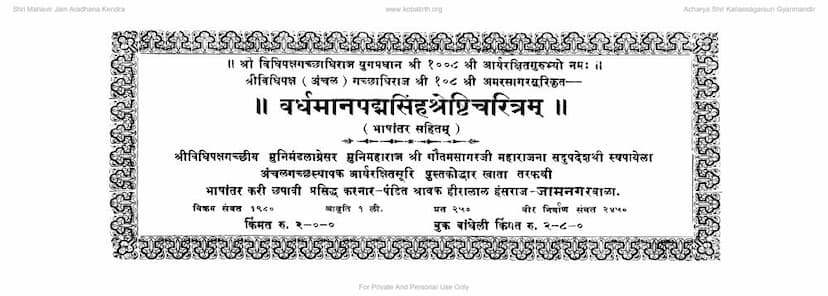Vardhaman Padmasinh Shreshthi Charitam
Added to library: September 2, 2025

Summary
Here's a comprehensive summary of the "Vardhaman Padmasinh Shreshthi Charitam" by Amarsagarsuri, based on the provided text:
Book Title: Vardhaman Padmasinh Shreshthi Charitam Author: Amarsagarsuri Publisher: Shravak Hiralal Hansraj
Overall Summary:
This text is a biographical account of two prominent Jain merchants, Vardhaman Shah and his brother Padmasinh Shah, who were influential figures in the Lalana lineage. The work details their lives, their devotion to Jainism, their business acumen, and their significant contributions to religious and charitable activities. It highlights their adherence to Jain principles, their interactions with spiritual leaders, and the miraculous interventions that aided them. The narrative also touches upon their family history, lineage, and the legacy they left behind.
Key Themes and Content:
-
Lineage and Ancestry: The story begins by tracing the lineage of Vardhaman and Padmasinh back to their ancestor, Lalan, who received a blessing from the clan deity. This divine favor is said to have continued through generations, aiding the family in times of need.
-
Vardhaman and Padmasinh: The narrative focuses on these two brothers, emphasizing their strong character, piety, and devotion to Jainism. They are portrayed as exemplary householders who balanced their worldly responsibilities with their spiritual commitments.
-
Miraculous Intervention (Gothra Devi): A significant theme is the intervention of their clan deity (Gothra Devi), who appears in various forms (including as a yogi) to assist the brothers. This divine help plays a crucial role in overcoming obstacles and achieving success.
-
Religious Devotion and Practices: The text details their commitment to Jain rituals, including fasting (Ashtam Tap), worship of deities (like Mahakali), and participation in religious ceremonies. They are shown to be deeply influenced by the teachings and guidance of Jain monks and Acharyas.
-
Business and Wealth: Vardhaman and Padmasinh were successful merchants. The text describes their trading activities, including voyages to foreign lands like China, and their ability to amass wealth through honest means. Their wealth is consistently depicted as being used for charitable purposes.
-
Charity and Religious Endeavors: A significant portion of the book is dedicated to their philanthropic activities. This includes building temples (like the one for Lord Shantinath and Lord Ajitnath), establishing charitable institutions, and supporting the Jain community. The text specifically mentions their extensive travels to various holy sites like Shatrunjay, Arbuda, and Sammeta Shikhar.
-
Guidance from Spiritual Leaders: The brothers frequently sought and received guidance from prominent Jain Acharyas, most notably Acharya Shri Kalyan Sagar Suri and his disciple Acharya Shri Amarsagar Suri (the author). These spiritual leaders played a vital role in shaping their lives and guiding their religious activities.
-
Overcoming Adversity: The narrative recounts instances where the brothers faced challenges, such as illness (Lalan's skin disease), family disputes, and financial setbacks. The divine interventions and their own piety are shown to help them navigate these difficulties.
-
Establishment of Legacy: The story concludes by highlighting the enduring legacy of Vardhaman and Padmasinh. Their descendants continued to uphold Jain principles and contribute to the community, with their names becoming synonymous with piety and prosperity within the Lalana lineage. The creation of this very text by Acharya Amarsagar Suri, at the behest of Jagad Shah (Vardhaman Shah's son), underscores their lasting impact.
-
Specific Incidents Mentioned:
- Lalan, an ancestor, receiving blessings from the clan deity.
- Lalan's son, Lakdhir, being afflicted with a skin disease and being miraculously cured through the intervention of Acharya Jayasingh Suri and the worship of Mahakali.
- Vardhaman and Padmasinh's merchant voyages, including to China, and their successful business dealings.
- Their extensive temple construction and renovation activities across various holy sites.
- The role of their loyal and wise ministers and family members in supporting their endeavors.
- The divine appearance of the clan deity in the form of a yogi to aid them.
- The story of the miraculous transformation of a copper pot into gold, attributed to the yogi's intervention.
- The construction and consecration of several Jain temples and idols.
- The narrative also mentions the political landscape, including the reign of King Jashvantji, during which these events unfolded.
Structure and Style:
The "Vardhaman Padmasinh Shreshthi Charitam" is presented as a narrative in Sanskrit, with Gujarati translations provided alongside. It is structured into several "Sargas" (chapters), each detailing different aspects of the lives of the protagonists and their predecessors. The language is devotional and poetic, aiming to inspire piety and adherence to Jain teachings.
In essence, the book serves as a hagiography, celebrating the virtuous lives of Vardhaman Shah and Padmasinh Shah, showcasing them as exemplars of Jain household spirituality, ethical business practices, and selfless charity, all under the watchful eyes of their divine protectors and spiritual guides.